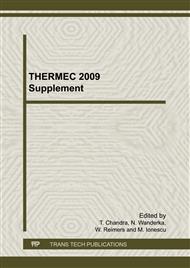p.425
p.431
p.437
p.443
p.449
p.455
p.461
p.467
p.473
3D Observation and Image-Based Finite Element Analyses of Fatigue Crack Propagation in an Al-Mg-Si Alloy
Abstract:
3D fatigue crack opening and propagation behaviors in an Al-Mg-Si alloy have been investigated in this study. A combined methodology of an in-situ 3D crack visualization via the synchrotron X-ray CT and image-based numerical simulation which takes into account real crack morphology has been applied for the study. The details of a crack with non-planar torturous crack morphology have been observed and many essential features of the crack and its opening/propagation inside the material have been identified. Typical example would be the complex deformation behaviors in the region where two crack segments lying on different horizontal planes overlap each other, and the influence of complicated crack front line on local crack driving forces. We recognized that two overlapping crack segments affected significantly the local crack driving force ΔkI each other, and large mode III displacement occurred near the edge of overlapping region. The region next to overlapping was influenced to a relatively large extent through shielding the near-tip stress/strain fields thereby reducing the local crack driving forces. We also found that the sharp extrusion on crack front line had no significant influence on neighboring cracks. The combined methodology of the in-situ 3D crack visualization and the image-based numerical simulation has been demonstrated to be powerful and feasible in revealing and understanding various fracture phenomena inside materials
Info:
Periodical:
Pages:
449-454
Citation:
Online since:
January 2010
Price:
Сopyright:
© 2010 Trans Tech Publications Ltd. All Rights Reserved
Share:
Citation:


